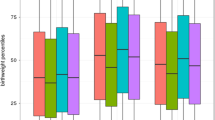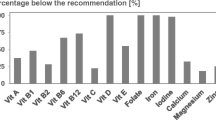Abstract
Background
Birth weight is a relevant predictor of childhood health outcomes. Studies investigating the association between modifiable risk factors, as the maternal diet quality, and birth weight are needed. We aimed to investigate the association between the Diet Quality Index Adapted for Pregnant Women (IQDAG) score and birth weight.
Methods
This is a prospective cohort that includes 547 Brazilian mother–child pairs. Dietary recalls and a food frequency questionnaire were obtained during pregnancy. Information on birth weight, sex, and gestation duration were obtained from the Live Birth Information System (SINASC).
Results
On total, 3.8% of the newborns were classified as low birth weight (LBW), 6.0% with macrosomia, 10.2% small for gestational age (SGA), and 11.2% large for gestational age (LGA). The mean (SD) IQDAG score was 70.1 (11.8). Adjusted logistic regression models showed that women in the third tertile of the IQDAG score presented a lower risk of having LGA babies [OR 0.44 (95% CI 0.22, 0.90), p-trend = 0.02] compared to the first tertile. Women in the third tertile of omega-3 intake presented a lower risk of giving birth to LGA infants [OR 0.33 (95% CI 0.15, 0.69), p-trend = 0.00] and LBW infants [OR 0.18 (95% CI 0.04, 0.83), p-trend = 0.02] when compared to the first tertile. There was also a lower SGA trend among the children of women in the third tertile of omega-3 intake [OR 0.43 (95% CI 0.17, 1.07), p-trend = 0.03] compared to the first tertile.
Conclusion
A better diet quality and higher omega-3 intake are protective factors for LGA babies, and increased maternal omega-3 intake reduce the risk of LBW and LGA, and may be a protective factor against the birth of SGA infants.

Similar content being viewed by others
References
Meadow W, Lee G, Lin K, Lantos J. Changes in mortality for extremely low birth weight infants in the 1990s: implications for treatment decisions and resource use. Pediatrics. 2004;113:1223–9.
Mathews TJ, MacDorman MF, Menacker F. Infant mortality statistics from the 2004 period linked birth/infant death data set. 2007. https://doi.org/10.1037/e558952006-001.
EGG Consortium, Warrington NM, Beaumont RN, Horikoshi M, Day FR, Helgeland Ø, et al. Maternal and fetal genetic effects on birth weight and their relevance to cardio-metabolic risk factors. Nat Genet. 2019;51:804–14.
Spracklen CN, Wallace RB, Sealy-Jefferson S, Robinson JG, Freudenheim JL, Wellons MF, et al. Birth weight and subsequent risk of cancer. Cancer Epidemiol. 2014;38:538–43.
Kerche LTRL, Abbade JF, Costa RAA, Rudge MVC, Calderon I de MP. Fatores de risco para macrossomia fetal em gestações complicadas por diabete ou por hiperglicemia diária. Rev Bras Ginecol Obstet. 2005;27. https://doi.org/10.1590/S0100-72032005001000003.
Shapiro ALB, Kaar JL, Crume TL, Starling AP, Siega-Riz AM, Ringham BM, et al. Maternal diet quality in pregnancy and neonatal adiposity: The Healthy Start Study. Int J Obes (Lond). 2016;40:1056–62.
Jang W, Kim H, Lee B-E, Chang N. Maternal fruit and vegetable or vitamin C consumption during pregnancy is associated with fetal growth and infant growth up to 6 months: results from the Korean Mothers and Children’s Environmental Health (MOCEH) cohort study. Nutr J. 2018;17:105.
World Health organization et al. Report of the commission on ending childhood obesity. Geneva: World Health Organization; 2017.
Brasil M da S. DATASUS—Nascidos vivos—Brasil. DATASUS Tecnologia da Informação a Serviço do SUS. 2020. http://tabnet.datasus.gov.br/cgi/tabcgi.exe?sinasc/cnv/nvuf.def. Accessed 6 Aug 2020.
Zhang C, Liu S, Solomon CG, Hu FB. Dietary fiber intake, dietary glycemic load, and the risk for gestational diabetes mellitus. Diabetes Care. 2006;29:2223–30.
Thangaratinam S, Rogozinska E, Jolly K, Glinkowski S, Roseboom T, Tomlinson JW, et al. Effects of interventions in pregnancy on maternal weight and obstetric outcomes: meta-analysis of randomised evidence. BMJ. 2012;344:e2088.
Emond JA, Karagas MR, Baker ER, Gilbert-Diamond D. Better diet quality during pregnancy is associated with a reduced likelihood of an infant born small for gestational age: an analysis of the prospective New Hampshire Birth Cohort Study. J Nutr. 2018;148:22–30.
Kourlaba G, Panagiotakos DB. Dietary quality indices and human health: a review. Maturitas. 2009;62:1–8.
Crivellenti LC, Zuccolotto DCC, Sartorelli DS. Development of a diet quality index adapted for pregnant women. Rev Saude Publica. 2018;52. https://doi.org/10.11606/S1518-8787.2018052000184.
Sartorelli DS, Crivellenti LC, Zuccolotto DCC, Franco LJ. Relationship between minimally and ultra-processed food intake during pregnancy with obesity and gestational diabetes mellitus. Cad Saúde Pública. 2019;35. https://doi.org/10.1590/0102-311x00049318.
Rohatgi KW, Tinius RA, Cade WT, Steele EM, Cahill AG, Parra DC. Relationships between consumption of ultra-processed foods, gestational weight gain and neonatal outcomes in a sample of US pregnant women. PeerJ. 2017;5. https://doi.org/10.7717/peerj.4091.
Crivellenti LC, Zuccolotto DCC, Sartorelli DS. Association between the Diet Quality Index Adapted for Pregnant Women (IQDAG) and excess maternal body weight. Rev Bras Saude Mater Infant. 2019;19:275–83.
Barbieiri P, Nunes JC, Torres AG, Nishimura RY, Zuccolotto DCC, Crivellenti LC, et al. Indices of dietary fat quality during midpregnancy is associated with gestational diabetes. Nutrition. 2016;32:656–61.
World Health Organization Consultation. Diagnostic criteria and classification of hyperglycaemia first detected in pregnancy: a World Health Organization Guideline. Diabetes Res Clin Pract. 2014;103:341–63.
Ministério da Saúde, Secretaria de Vigilância em Saúde, Diretoria de Apoio Administrativo ao Sistema de Saúde. DATASUS—SINASC—Sistema de Informação sobre Nascidos Vivos. 2020. http://tabnet.datasus.gov.br/cgi/tabcgi.exe?sinasc/cnv/nvbr.def. Accessed 29 Sep 2019.
Barros FC, Victora CG. Epidemiologia da saúde infantil: um manual para diagnósticos comunitários [Epidemiology and child health: a manual for communitary diagnosis]. Säo Paulo; Hucitec-UNICEF; 1991. 176 p.
Villar J, Ismail LC, Victora CG, Ohuma EO, Bertino E, Altman DG, et al. International standards for newborn weight, length, and head circumference by gestational age and sex: the Newborn Cross-Sectional Study of the INTERGROWTH-21st Project. Lancet. 2014;384:857–68.
Ota E, Haruna M, Suzuki M, Anh DD, Tho LH, Tam NTT, et al. Maternal body mass index and gestational weight gain and their association with perinatal outcomes in Viet Nam. Bull World Health Organ. 2011;89:127–36.
Johnson RK, Soultanakis RP, Matthews DE. Literacy and body fatness are associated with underreporting of energy intake in US low-income women using the multiple-pass 24-hour recall: a doubly labeled water study. J Am Dietetic Assoc. 1998;98:1136–40.
Barbieri P, Crivellenti LC, Nishimura RY, Sartorelli DS. Validation of a food frequency questionnaire to assess food group intake by pregnant women. J Hum Nutr Diet. 2015;28:38–44.
TACO. http://www.nepa.unicamp.br/taco/tabela.php?ativo=tabela. Accessed 29 Sep 2019.
Food Composition Databases Show Foods List. https://ndb.nal.usda.gov/ndb/search/list. Accessed 29 Sep 2019.
Goldberg GR, Black AE, Jebb SA, Cole TJ, Murgatroyd PR, Coward WA, et al. Critical evaluation of energy intake data using fundamental principles of energy physiology: 1. Derivation of cut-off limits to identify under-recording. Eur J Clin Nutr. 1991;45:569–81.
On behalf of the EFCOVAL Consortium, Harttig U, Haubrock J, Knüppel S, Boeing H. The MSM program: web-based statistics package for estimating usual dietary intake using the Multiple Source Method. Eur J Clin Nutr. 2011;65:S87–91.
Haubrock J, Nöthlings U, Volatier J-L, Dekkers A, Ocké M, Harttig U, et al. Estimating usual food intake distributions by using the multiple source method in the EPIC-Potsdam Calibration Study. J Nutr. 2011;141:914–20.
Takito MY, Neri L, de CL, Benício MHD. Avaliação da reprodutibilidade e validade de questionário de atividade física para gestantes. Rev Bras Med Esport. 2008;14:132–8.
Critério Brasil—ABEP. http://www.abep.org/criterio-brasil. Accessed 29 Sep 2019.
Rasmussen KM, Yaktine AL, Institute of Medicine (U.S.) (eds.). Weight gain during pregnancy: reexamining the guidelines. Washington, DC: National Academies Press; 2009.
WHO. Obesity: preventing and managing the global epidemic: report of a WHO Consultation on Obesity, Geneva, 3–5 June 1997. 1998. https://apps.who.int/iris/handle/10665/63854. Accessed 5 Oct 2019.
Atalah E, Castillo C, Castro R, Aldea A. Proposal of a new standard for the nutritional assessment of pregnant women. 1997. https://www.ncbi.nlm.nih.gov/pubmed/9609018. Accessed 5 Oct 2019.
World Health Organization. Diagnostic criteria and classification of hyperglycaemia first detected in pregnancy: a World Health Organization Guideline. Diabetes Res Clin Pract 2014;103:341–63.
von Elm E, Altman DG, Egger M, Pocock SJ, Gøtzsche PC, Vandenbroucke JP. The Strengthening the Reporting of Observational Studies in Epidemiology (STROBE) statement: guidelines for reporting observational studies. J Clin Epidemiol. 2008;61:344–9.
Grandy M, Snowden JM, Boone-Heinonen J, Purnell JQ, Thornburg KL, Marshall NE. Poorer maternal diet quality and increased birth weight. J Matern Fetal Neonatal Med. 2018;31:1613–9.
Hillesund ER, Bere E, Haugen M, Øverby NC. Development of a New Nordic Diet score and its association with gestational weight gain and fetal growth—a study performed in the Norwegian Mother and Child Cohort Study (MoBa). Public Health Nutr. 2014;17:1909–18.
Poon AK, Yeung E, Boghossian N, Albert PS, Zhang C. Maternal dietary patterns during third trimester in association with birthweight characteristics and early infant growth. Scientifica. 2013;2013:1–7.
Chiuve SE, Fung TT, Rimm EB, Hu FB, McCullough ML, Wang M, et al. Alternative dietary indices both strongly predict risk of chronic disease. J Nutr. 2012;142:1009–18.
Trichopoulou A, Costacou T, Bamia C, Trichopoulos D. Adherence to a Mediterranean diet and survival in a Greek population. N Engl J Med. 2003;348:2599–608.
Olsen S, Sørensen Thorkild IA, Secher N, Hansen H, Jensen B, Sommer S, et al. Intake of marine fat, rich in (n-3)-polyunsaturated fatty acids, may increase birthweight by prolonging gestation. Lancet. 1986;328:367–9.
Grootendorst-van Mil NH, Tiemeier H, Steenweg-de Graaff J, Koletzko B, Demmelmair H, Jaddoe VWV, et al. Maternal plasma n-3 and n-6 polyunsaturated fatty acids during pregnancy and features of fetal health: fetal growth velocity, birth weight and duration of pregnancy. Clin Nutr. 2018;37:1367–74.
Vannuccini S, Bocchi C, Severi FM, Challis JR, Petraglia F. Endocrinology of human parturition. Annales d’Endocrinologie. 2016;77:105–13.
Lucero D, Olano C, Bursztyn M, Morales C, Stranges A, Friedman S, et al. Supplementation with n-3, n-6, n-9 fatty acids in an insulin-resistance animal model: does it improve VLDL quality? Food Funct. 2017;8:2053–61.
Pérez-Matute P, Pérez-Echarri N, Martínez JA, Marti A, Moreno-Aliaga MJ. Eicosapentaenoic acid actions on adiposity and insulin resistance in control and high-fat-fed rats: role of apoptosis, adiponectin and tumour necrosis factor-α. Br J Nutr. 2007;97:389–98.
Chia A-R, de Seymour JV, Colega M, Chen L-W, Chan Y-H, Aris IM, et al. A vegetable, fruit, and white rice dietary pattern during pregnancy is associated with a lower risk of preterm birth and larger birth size in a multiethnic Asian cohort: the Growing Up in Singapore Towards healthy Outcomes (GUSTO) cohort study. Am J Clin Nutr. 2016;104:1416–23.
Brasil, Ministério da Saúde. Guia alimentar para a população brasileira. Brasília, DF: Ministério da Saúde; 2014.
Funding
This work was funded by the São Paulo Research Foundation (FAPESP 2018/06746-8), and National Council for Scientific and Technological Development (CNPq 472221/2010-8, and 302498/2015-0).
Author information
Authors and Affiliations
Contributions
ISS, LJF, and DSS designed research; ISS, LCC, and DSS conducted research; ISS, LCC, and DSS analyzed data; ISS and DSS wrote the paper; DSS had primary responsibility for final content. All authors reviewed and approved the final version of the manuscript.
Corresponding author
Ethics declarations
Conflict of interest
The authors declare no competing interests.
Additional information
Publisher’s note Springer Nature remains neutral with regard to jurisdictional claims in published maps and institutional affiliations.
Rights and permissions
About this article
Cite this article
Santos, I.d.S., Crivellenti, L.C., Franco, L.J. et al. Relationship between the quality of the pregnant woman’s diet and birth weight: a prospective cohort study. Eur J Clin Nutr 75, 1819–1828 (2021). https://doi.org/10.1038/s41430-021-00894-6
Received:
Revised:
Accepted:
Published:
Issue Date:
DOI: https://doi.org/10.1038/s41430-021-00894-6
- Springer Nature Limited




